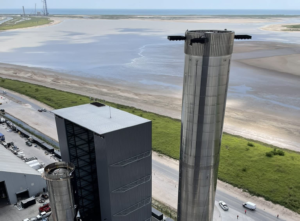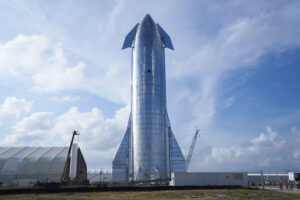
SpaceX Tests New Starship Stage 0 Pad Protection
After Starship’s first launch, SpaceX was left with a bit more damage than they had hoped for and expected to stage 0. Despite this, Elon was confident that in only a few months the pad would be not only fixed but improved and ready for the next flight. With it now being one month since the launch, the progress at this site has been quite staggering.
Teams at SpaceX have been working constantly and the ambitious timeline from Musk is becoming more realistic. This being said, there is still a lot of work and especially testing remaining to make sure what happened on the first launch doesn’t happen again. Just yesterday, we received more information on tests the company has been conducting for months now related to Stage 0.
This included footage of a Raptor engine firing onto a water cooled steel plate. Based on the construction and what SpaceX has said, this steel structure will be the main infrastructure to withstand and deflect the force of 33 Raptors firing under Super Heavy. Here I will go more in-depth into the new tests on this steel plate, other examples of steel at launch pads, what to expect in the coming weeks, and more.
Steel Plate Tests

Musk had mentioned soon after the launch that various pad protection systems had been under construction for months prior to Starship’s first launch. However, SpaceX received its launch license from the FAA on the 14th, and only 6 days after, Starship was in the air. By now we know that the company was eager to fly and thought that the special heat-resistant Fondag concrete would hold up for at least one launch.
In relation to this, just yesterday, SpaceX tweeted saying, “Raptor test firing into a water cooled steel plate”. This included a video of the Raptor igniting and shooting its exhaust straight into the center of a nearby steel plate propped up vertically. This video and update give us a few important insights into this process and the future of Stage 0. For one, it’s very likely that tests exactly like this one have been going on for weeks if not months now. While not implemented in time for the first launch, the company knew that a long term solution was necessary to handle the exhaust of 33 Raptor engines.
Focusing more on the test footage itself, it highlights the immense power of the Raptor engine and gives an idea of what the company is up against. While the video cuts off right after the Raptor stops firing, you can see that the plate is still standing and looks to be intact. Obviously, this is only a single Raptor and not 33, but you have to consider the extra surface area and size of a full water cooled steel plate and also the distance. In the test footage based on the Raptor size, the steel test plate looks to be around 7 meters away from the engine. This is a much closer distance than the space between the top of the Orbital Launch Mount and the ground where a full plate will be installed. In reality, the distance will be around twice this at close to 15 meters.
With all things considered, this test is very impressive and must be giving SpaceX the confidence to continue as more progress can be seen at Boca Chica. If tests like these were not performing as expected or better, the company would be thinking of alternative solutions. Also, in a way, this water-cooled steel plate will need to perform and survive much more than just a single launch. In order for Starship to be rapidly reusable as intended, the pad and all the supporting structures need to be as well. There is no point of a water cooled steel plate if after one or two launches SpaceX needs a few weeks to repair and fix it.
Right now in the early stages of Starship integrated test flights, we might see this but in the future, they need an extremely capable and reliable system. In the coming weeks, we can expect more testing like this from the company and eventually a full 33-engine static fire above the steel plates. They will likely start with partial thrust and move up to a full static fire. If it holds up as intended then the next Starship launch should shoot nothing but dust in the air.
Other Examples

It’s quite common within the space industry to see steel in some way shape or form part of either flame diverters or trenches at different launch pads. While Starship is more, the nearly nine million pounds of thrust expended during lift-off of NASA’s Space Launch System (SLS) rocket would cause quite a bit of damage if it wasn’t for modifications made to Launch Pad 39B.
Construction began on the main flame deflector in July 2017. The deflector incorporates several novel design approaches, including steel cladding plates, an open structure on the south side, and a configuration that maximizes functionality with commercial launch vehicles. “The thick steel plates are designed to withstand the exhaust and heat from several launches,” said Nick Moss, EGS pad deputy project manager. “There is flexibility of maintenance; as steel plates closest to the exhaust plume begin to erode, they can be replaced.”
Based on these comments, it’s likely that in SpaceX’s case at Stage 0 after a few launches work will need to be done to either fix or replace steel plates. The system could be designed in a way that supports this process and makes it very quick. Focusing back on Pad 39B, approximately 100,000 heat-resistant bricks, in three different sizes, were secured to the walls using bonding mortar, and where required, steel plate anchors. In areas where significant temperature and pressure will occur, steel plate anchors were fastened into the walls at intervals to reinforce the brick system. So far this system has held up very well even with the first launch of the Space Launch System.
In addition, after SpaceX and Elon began mentioning the use of Steel plates for Starship’s pad, Dr. Phil Metzger gave some valuable insight. He worked on different Morpheus launch locations and used steel plates in certain instances so that they weren’t tied down to places with concrete. In a quote, he said, “So compare to Elon’s tweet about Starship. They plan to make their giant steel plate water-cooled. That way it doesn’t have to be large enough to take all the heat of the plume without melting, the way we designed the Morpheus steel plates. For such a large rocket that much steel would be excessive. And ablative would not be enough to solve this, either. Would the ablative need to be 3 feet thick?!! But he said it will be water-cooled, which is an awesome idea. The water will be taking heat out of the steel in real time so it won’t melt. Simple, and it should be effective” he said.
When it comes to adequately dispersing the exhaust of the most powerful rocket in the world, there are a few reasons why SpaceX is going down this steel plate path. To start off, it would be hard for SpaceX to build a large trench due to the high water table in Boca Chica. The water table is an underground boundary between the soil surface and the area where groundwater saturates spaces between sediments and cracks in the rock. As a solution to this, you can build up the ground level quite a bit and then make a trench with the extra room. In SpaceX’s case, they already have set up all the Stage 0 infrastructure meaning we can expect everything to stay at the level it’s at currently. While possible, SpaceX is confident that they can add this system within a few months’ time and be ready rather than a massive construction project. This is why the use of a large steel plate is the current plan. The plates are designed to sit directly on top of the water pipes, which are over 6 feet wide. Those pipes need to be buried underground for the plates to be at ground level.
Looking at more tests and info related to steel plates, after the launch of SLS, NASA did an assessment of the pad infrastructure. “The exploration ground systems exceeded our expectation for its overall performance,” Artemis mission manager, Mike Sarafin said during a Nov. 21 news briefing following Orion’s closest lunar flyby. “We did have a little bit of damage on the mobile launcher, but it will be ready to support Artemis II and we had accounted for that previously in our pre-plan and our budget for the time between Artemis I and II” he said.
The assessment enabled teams to inspect areas on the mobile launcher and identify specific damage and debris around the pad. Engineers identified minor damage to umbilicals and the crew access arm on the mobile launcher. Damage to the pneumatic lines associated with gaseous nitrogen and gaseous helium caused the oxygen sensors on the pad to show there were low oxygen readings due to leaks, which teams have since isolated. The most significant issue is the damage to the elevators, which required the team to use the stairs for inspections on the 355-foot-tall tower structure, which has 662 steps, and extended the time required for the inspection. The elevators will remain out of service for several months to complete repairs. As for the deflector and steel plates, they held up as intended despite the immense amount of heat and force.
Conclusion
SpaceX has been testing steel plates for likely months now in preparation for the installation of a massive system under the OLM. Once installed, we can expect a few tests to be completed before the second integrated test flight of Starship. We will have to wait and see how it progresses and the impact it has on the space industry.



